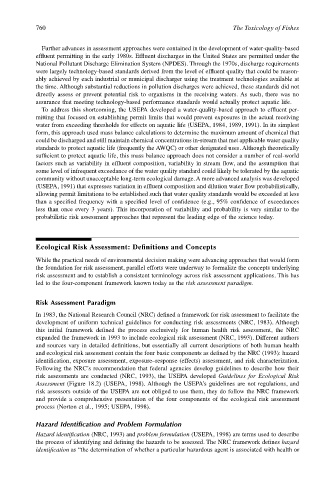Page 780 - The Toxicology of Fishes
P. 780
760 The Toxicology of Fishes
Further advances in assessment approaches were contained in the development of water-quality-based
effluent permitting in the early 1980s. Effluent discharges in the United States are permitted under the
National Pollutant Discharge Elimination System (NPDES). Through the 1970s, discharge requirements
were largely technology-based standards derived from the level of effluent quality that could be reason-
ably achieved by each industrial or municipal discharger using the treatment technologies available at
the time. Although substantial reductions in pollution discharges were achieved, these standards did not
directly assess or prevent potential risk to organisms in the receiving waters. As such, there was no
assurance that meeting technology-based performance standards would actually protect aquatic life.
To address this shortcoming, the USEPA developed a water-quality-based approach to effluent per-
mitting that focused on establishing permit limits that would prevent exposures in the actual receiving
water from exceeding thresholds for effects on aquatic life (USEPA, 1984, 1989, 1991). In its simplest
form, this approach used mass balance calculations to determine the maximum amount of chemical that
could be discharged and still maintain chemical concentrations in-stream that met applicable water quality
standards to protect aquatic life (frequently the AWQC) or other designated uses. Although theoretically
sufficient to protect aquatic life, this mass balance approach does not consider a number of real-world
factors such as variability in effluent composition, variability in stream flow, and the assumption that
some level of infrequent exceedance of the water quality standard could likely be tolerated by the aquatic
community without unacceptable long-term ecological damage. A more advanced analysis was developed
(USEPA, 1991) that expresses variation in effluent composition and dilution water flow probabilistically,
allowing permit limitations to be established such that water quality standards would be exceeded at less
than a specified frequency with a specified level of confidence (e.g., 95% confidence of exceedances
less than once every 3 years). This incorporation of variability and probability is very similar to the
probabilistic risk assessment approaches that represent the leading edge of the science today.
Ecological Risk Assessment: Definitions and Concepts
While the practical needs of environmental decision making were advancing approaches that would form
the foundation for risk assessment, parallel efforts were underway to formalize the concepts underlying
risk assessment and to establish a consistent terminology across risk assessment applications. This has
led to the four-component framework known today as the risk assessment paradigm.
Risk Assessment Paradigm
In 1983, the National Research Council (NRC) defined a framework for risk assessment to facilitate the
development of uniform technical guidelines for conducting risk assessments (NRC, 1983). Although
this initial framework defined the process exclusively for human health risk assessment, the NRC
expanded the framework in 1993 to include ecological risk assessment (NRC, 1993). Different authors
and sources vary in detailed definitions, but essentially all current descriptions of both human health
and ecological risk assessment contain the four basic components as defined by the NRC (1993): hazard
identification, exposure assessment, exposure–response (effects) assessment, and risk characterization.
Following the NRC’s recommendation that federal agencies develop guidelines to describe how their
risk assessments are conducted (NRC, 1993), the USEPA developed Guidelines for Ecological Risk
Assessment (Figure 18.2) (USEPA, 1998). Although the USEPA’s guidelines are not regulations, and
risk assessors outside of the USEPA are not obliged to use them, they do follow the NRC framework
and provide a comprehensive presentation of the four components of the ecological risk assessment
process (Norton et al., 1995; USEPA, 1998).
Hazard Identification and Problem Formulation
Hazard identification (NRC, 1993) and problem formulation (USEPA, 1998) are terms used to describe
the process of identifying and defining the hazards to be assessed. The NRC framework defines hazard
identification as “the determination of whether a particular hazardous agent is associated with health or

